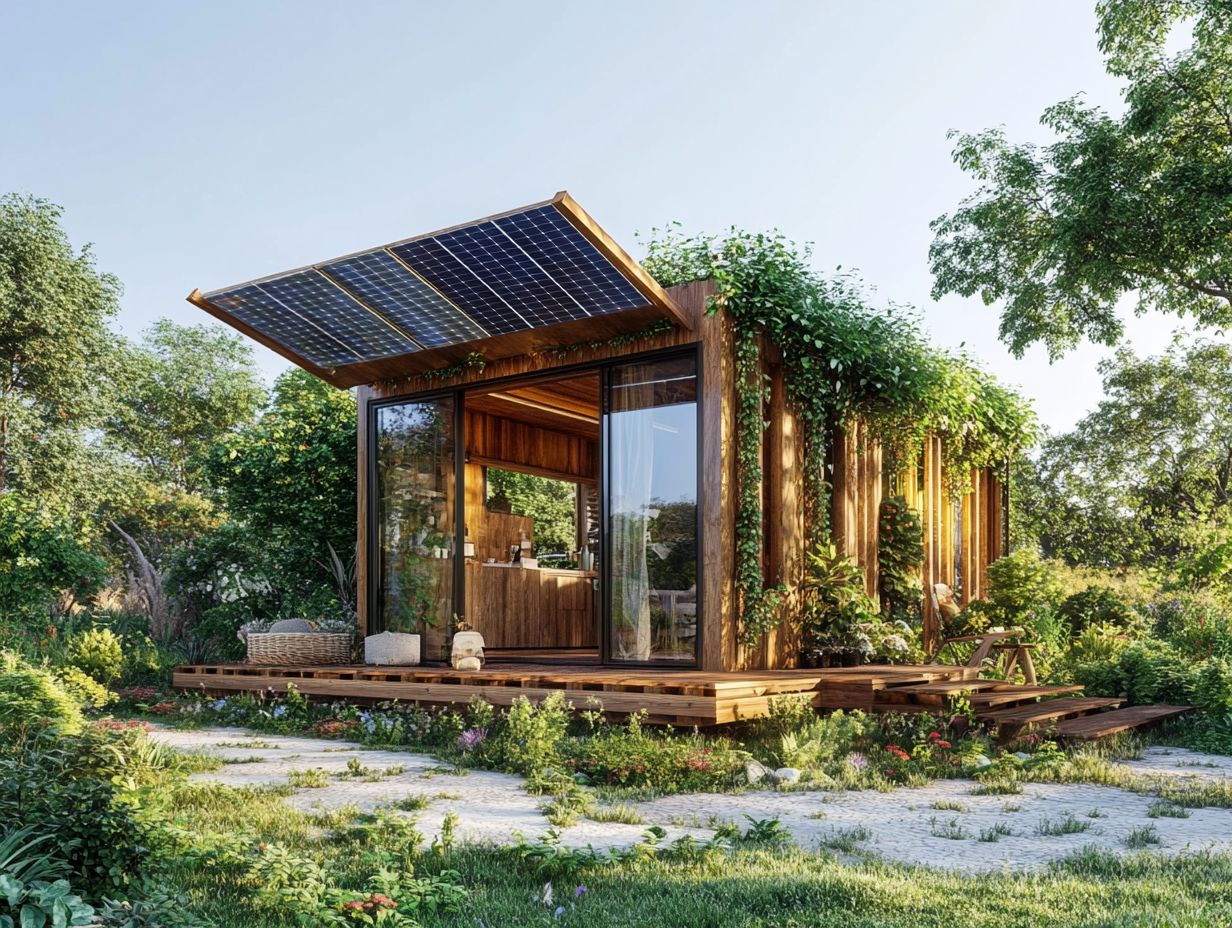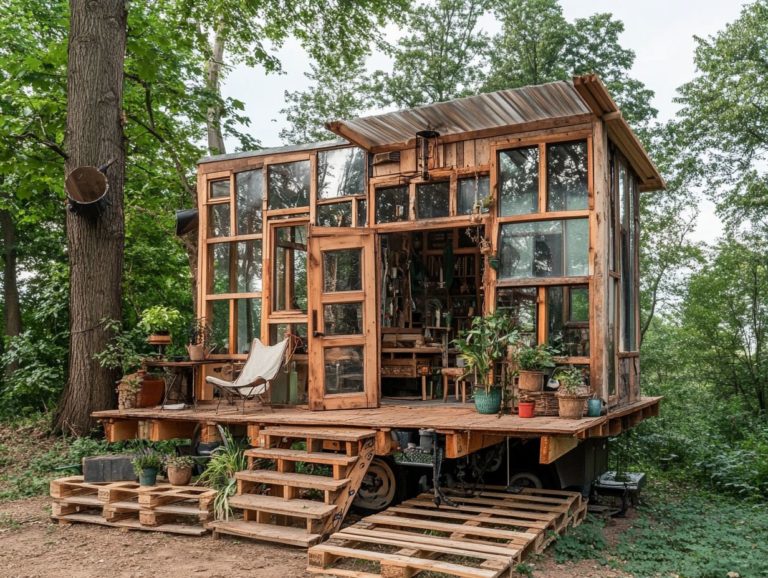The Future of Sustainable Materials in Tiny Housing
The tiny house movement transcends mere trendiness; it s a thoughtful response to the growing demand for sustainable living solutions. It appeals to those interested in living intentionally.
As you seek a lifestyle rooted in minimalism and eco-friendliness, tiny homes present an innovative opportunity to reduce your carbon emissions while maximizing limited space, especially with solutions like multi-functional furniture.
This article delves into the rise of tiny housing, highlighting its benefits, sustainable materials, and cutting-edge technologies like smart home innovations that make these homes both practical and environmentally responsible.
We ll also tackle challenges like cost and accessibility. Envision a future where tiny living seamlessly harmonizes with sustainability and offers financial freedom.
Explore with us as we unveil the transformative potential of tiny housing in reshaping communities and enriching lifestyles through eco-friendly practices.
Contents
- Key Takeaways:
- The Rise of Tiny Housing
- Sustainable Materials for Tiny Housing
- Challenges and Solutions for Sustainable Tiny Housing
- Innovative Technologies for Tiny Housing
- The Future of Tiny Housing and Sustainable Materials
- Frequently Asked Questions
- What is the current state of sustainable materials in tiny housing?
- Why is the use of sustainable materials important in tiny housing, especially in the context of eco-friendly practices?
- What are some examples of sustainable materials used in tiny housing?
- Are there any downsides to using sustainable materials in tiny housing?
- How do you see the future of sustainable materials in tiny housing evolving?
- Can sustainable materials be used in all aspects of tiny housing, including plumbing and electrical systems?
Key Takeaways:

- Tiny housing is on the rise, offering benefits like affordability and minimalist living.
- Sustainable materials, such as eco-friendly construction options like bamboo flooring and reclaimed materials, are gaining popularity.
- Despite challenges, like cost and accessibility, the future of tiny housing looks bright with innovative technologies and advancements in sustainable building techniques.
The Rise of Tiny Housing
The tiny house movement is changing how we view living spaces. It promotes sustainable living and financial freedom, resonating with today s environmental consciousness.
As you explore tiny living, you’ll discover solutions that minimize your environmental impact and promote community living. This approach also encourages the use of renewable energy sources like solar panels and wind turbines, leading to eco-friendly housing options that are both practical and impactful.
Exploring the Trend and its Benefits
Discover the exciting trend of tiny housing, which reveals a commitment to affordability and environmental awareness. This trend attracts diverse demographics worldwide.
For many, tiny housing has become a practical solution to soaring real estate prices. Homeowners can save as much as 50% on housing costs compared to traditional homes. These compact dwellings often incorporate eco-friendly materials and energy-efficient designs, leading to significant reductions in resource consumption. Understanding the role of sustainability in tiny house construction estimates suggest nearly a 45% decrease in overall carbon emissions.
Tiny housing also cultivates a genuine sense of community. Residents find value in shared spaces and collaborative living arrangements, like those offered by Tumbleweed Tiny House Company. These connections help combat the isolation often experienced in larger settings.
Numerous tiny house communities stand as a testament to this, showcasing increased engagement among neighbors and transforming their living environments into vibrant hubs of communal activity.
Sustainable Materials for Tiny Housing
Sustainable materials like timber and bamboo flooring are essential in tiny housing. They provide eco-friendly options that enhance both the aesthetic appeal and the environmental footprint of compact homes.
By choosing these materials and incorporating greywater recycling techniques, you create a beautiful living space while making a meaningful contribution to a healthier planet.
Eco-Friendly Options for Construction and Design

Eco-friendly options in the tiny house movement offer innovative insulation techniques and energy efficiency. These features maximize the use of natural light, making your home sustainable and livable.
Incorporating materials like cellulose or sheep’s wool for insulation enhances thermal performance. These materials significantly reduce your carbon footprint. Many tiny homes utilize hempcrete, a biocomposite that provides excellent insulation while being breathable. This prevents moisture buildup effectively, aligning with the future of sustainable materials in tiny housing.
The strategic placement of large windows and skylights harnesses natural light, reducing the need for artificial lighting. A striking example is a tiny home built from repurposed shipping containers by Jay Shafer. This design showcases sustainable living with heat-reflective roofing and solar energy systems, blending functionality with an eco-friendly ethos. Additionally, using earthbags for sustainable tiny house building is another innovative approach to enhance sustainability.
Challenges and Solutions for Sustainable Tiny Housing
While the benefits of sustainable tiny housing are abundant, challenges related to affordability and accessibility remain.
These challenges require innovative solutions that meet the diverse needs of communities and accommodate different lifestyle choices, like remote work.
Addressing Cost and Accessibility Issues
Tackling cost and accessibility issues within the tiny house movement is crucial for fostering financial freedom. This is especially important for individuals seeking alternative lifestyles, such as remote work and intentional living.
Explore exciting strategies and programs designed to meet these challenges. Initiatives promoting affordable land access and utilizing innovative designs can open doors for aspiring homeowners. This allows them to invest in a sustainable lifestyle without excessive debt.
Financial education is essential. Understanding budgeting and financing options empowers you to navigate the complexities of tiny house ownership with confidence. Community-based initiatives, such as group buying programs or cooperative living arrangements, can further reduce costs while fostering a sense of belonging.
Together, these methods cultivate a more inclusive environment for those embracing this transformative lifestyle.
Innovative Technologies for Tiny Housing
Innovative technologies are redefining tiny housing. These include smart home technologies, alternative energy sources like solar panels and wind turbines, and high-efficiency appliances.
These advancements enhance the functionality and sustainability of compact living spaces, making them appealing and efficient.
Advancements in Sustainable Building Techniques

Recent advancements in sustainable building techniques have transformed tiny home construction.
These techniques emphasize innovative insulation methods and eco-friendly practices that enhance energy efficiency. They also incorporate biophilic design, which connects people with nature.
Using advanced materials like structural insulated panels (SIPs) and reclaimed materials boosts thermal performance and reduces waste. A standout example is a tiny home crafted by ‘Tiny Heirloom’, which cleverly integrates solar panels and rainwater harvesting systems. This illustrates how innovations, including the role of textiles in tiny house design, can transform even the coziest living spaces into sustainable sanctuaries.
Embracing modular building techniques facilitates quicker assembly while lowering resource consumption. This aligns tiny homes with modern environmental objectives, such as using recycled materials in tiny house designs.
The Future of Tiny Housing and Sustainable Materials
The future of tiny housing and sustainable materials is undeniably bright. Trends are shifting toward environmentally friendly practices and community-centered living, reflecting a society that is becoming increasingly environmentally conscious.
As you explore this evolving landscape, you’ll find that these developments cater not only to a desire for simplicity but also promote a deeper connection to the planet and to one another.
Predictions and Possibilities
Predictions for the tiny house movement suggest a new era of sustainability and intentional living. More individuals are prioritizing minimalism, community living, and environmental consciousness in housing choices.
This growing interest in compact living extends beyond cost savings. It reflects a broader cultural shift that values experiences over possessions and emphasizes homemade designs.
As urban areas become more densely populated, the need for efficient space use is likely to accelerate the tiny house trend. This could lead to innovative designs that maximize functionality without sacrificing comfort.
With advancements in eco-friendly materials and smart home technology, tiny homes are likely to attract those seeking sustainable options that adapt to various lifestyles. For insights on the latest trends, check out the future of tiny house design. Communities are increasingly embracing shared resources and cooperative living arrangements, like those seen in Maidla Nature Resort. This evolution may include communal spaces, fostering a sense of belonging while minimizing individual footprints.
Frequently Asked Questions
What is the current state of sustainable materials in tiny housing?

Currently, sustainable materials are utilized in many tiny housing projects. However, there is still room for improvement and innovation in this field.
Why is the use of sustainable materials important in tiny housing, especially in the context of eco-friendly practices?
Sustainable materials minimize environmental impact and contribute to the durability and energy efficiency of tiny homes, playing a vital role in the Tiny House Movement.
What are some examples of sustainable materials used in tiny housing?
Commonly used sustainable materials in tiny housing include reclaimed wood, bamboo, cork flooring, recycled metal, and low-VOC paints. These materials are often sourced from companies like Tumbleweed Tiny House Company and D houses.
Are there any downsides to using sustainable materials in tiny housing?
While sustainable materials may have a higher upfront cost, they typically offer a longer lifespan. This can lead to savings in the long run due to reduced energy costs and maintenance, especially in innovative designs by Jay Shafer and the TruForm Tiny models.
How do you see the future of sustainable materials in tiny housing evolving?
As awareness of sustainable living grows and demand for tiny housing increases, such as at Maidla Nature Resort and Yoki Treehouse, we can expect more innovative and eco-friendly materials to be used in construction.
Can sustainable materials be used in all aspects of tiny housing, including plumbing and electrical systems?
Yes, sustainable options are available for plumbing, such as low-flow toilets and greywater systems. For electrical systems, there are solutions like solar panels and energy-efficient appliances, including products from Solar Solutions and Timber.
Explore the exciting possibilities of tiny housing and consider incorporating sustainable materials into your own living space!






